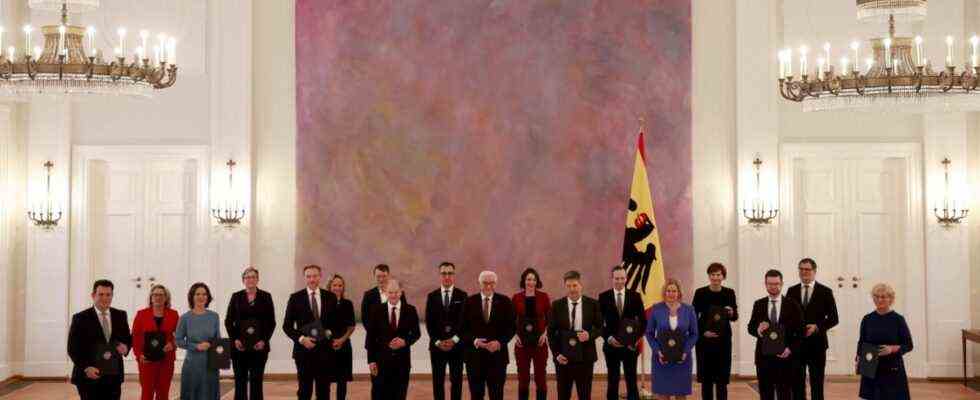When it’s festive at Bellevue Palace, it often happens in front of an abstract, violet-colored canvas that, measuring six by six meters, resembles a huge, voluminous pillow. It was the same on Wednesday when Federal President Frank-Walter Steinmeier first presented the new Chancellor Olaf Scholz with his certificate of appointment and later also the newly sworn ministers of the Ampel Coalition.
It was Richard von Weizsäcker, who was passionate about art and culture, who commissioned the Düsseldorf painter Gotthard Graubner (1930-2013) to create two large, wall-sized formats for the large dining room in Bellevue Palace at the end of the 1980s. In the spring of 1989 the two giant pillows entitled “Encounters” were installed in the castle. Since then, the raised Graubner cushions (the artist preferred to call them “color space bodies”) have ensured that the receptions, concerts, medals or state banquets organized by the respective Federal President always appear culturally dignified, but sometimes also appear slightly psychedelic. The counterpart to the purple mist of color that often appears on the news is an equally large abstraction on the opposite wall. But she rarely makes it onto television. Is it perhaps because the color yellow plays the main role here in less appetizing nuances?
The play with light and color made Graubner a postmodern revenant of romanticism in the eyes of some critics
Color, light and space – these three elements determine the art of Graubner, who was praised for his color sensitivity. The painter put his material on the canvases by buckets. His tools not only included brushes, but also wipers, so-called squeegees or sponges. The skilful play with light and color made the representative of post-war modernism a post-modern revenant of romanticism in the eyes of some critics. An association that Graubner, who admired Caspar David Friedrich, was sure to like. Graubner’s paint mist pictures, on the other hand, were often compared with those of Friedrich’s contemporaries, the British William Turner.
The artist Gotthard Graubner painted two large-format pictures for the dining room of Bellevue Palace on behalf of Federal President Richard von Weizsäcker.
(Photo: Horst Ossinger / Picture Alliance / dpa)
Born in the Saxon Vogtland, the artist moved from Dresden to Düsseldorf as a young man in 1954, long before the inner German Wall was built, where he finished his art studies that he had begun in the East. Then he succeeded in a German model career. The painter took part in the Documenta twice, in 1968 and 1977, and in 1982 he exhibited in the German pavilion at the Venice Biennale. From the mid-seventies to the end of the nineties he worked as a professor at the State Art Academy in Düsseldorf. His most famous student is the internationally acclaimed Berlin painter Katharina Grosse. “I don’t use color as an illustration of literary subjects; color is a subject enough for me,” Graubner used to say. The opposite is true for the traffic light coalition that is now starting. It must find answers to the pressing crises and issues of the present using the means of politics. It must not get lost in the depths of political color theory.

